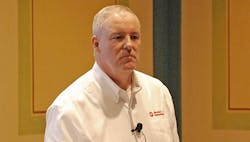Six ways to supercharge cloud computing
“Installing and updating software is not value-add time.” Together with colleague Oliver Haya, Rockwell Automation’s Leo Kilfoy discussed the many advantages of using cloud-based SaaS software in operational technology (OT) environments.
There are as many ways the modern manufacturer can benefit from cloud computing empowered by software-as-a-service (SaaS) as there are clouds on a rainy day.
In their ROKLive 2022 presentation, “Cloud-based Software as a Service: The Future of Industrial Automation is Here,” presenters Leo Kilfoy, director SaaS & digital design, Rockwell Automation, and Oliver Haya, commercial product manager, Rockwell Automation, spotlighted just six of those ways.
But first, they explained how SaaS compares to existing, more traditional software solutions. While embedded software runs on specific automation hardware, local computing is performed on laptops or workstations, and the on-prem approach happens within servers located in the building, the SaaS applications run in regional data centers, purchased on a subscription model that covers maintenance costs, and shifts responsibilities for software upkeep from the user to the provider.
Without a hint of hyperbole, the presenters claimed that SaaS is, quite simply, transforming how we all work. It is accelerating time to value. Boosting collaboration among teams. And unlocking unprecedented data value. “We see this as an enabling factor to help operational technology (OT) catch up to IT,” said Haya. “This is OT operated and IT managed, both working together, to allow us to deliver software, as a service, to the edge.”
To orient the audience about the SaaS approach in the industrial space, the presenters prompted them to consider how frequently they rely on SaaS solutions in their personal lives—when playing videogames or making dinner reservations or booking an Airbnb. “This is part of our daily lives,” surmised Haya. “And it is already part of our work lives. Think about your CRM or your financial reporting. This is another tool in our toolchests.”
Let’s get back to the benefits. Kilfoy walked through those half-dozen ways that SaaS is enabling modern industrial teams to optimize processes. These include:
Access everywhere—SaaS enables users to do what they do from any device anywhere with an internet connection. Web-delivered content is suited for different device types and operating systems. Software is available on-the-go, without the need for heavy-duty workstations.
“Installing and updating software is not value-add time,” explained Kilfoy. “You want your employees focused on creating value. SaaS provides ways to have your software always up to date. And if COVID taught us anything, it is the tremendous value in the ability for remote teams to work together.”
Collaboration—SaaS relies on single-source-of-truth documents, breaks down data silos, and enables partnering across locations and partnerships. “This extends beyond your local office,” said Kilfoy, noting how contractors, suppliers and customers can also collaborate with this approach.
Added Haya, “You can do a lot of this stuff without SaaS—with thumb-drives or emails of whatever—but it is so much easier with it.”
On-demand scaling: As you grow, SaaS enables your software and infrastructure to grow, too. Enterprises can start small and add users over time. Capital expenditures and maintenance costs are minimized. There are greater capabilities with data analytics.
Cost: The SaaS approach offers users predictive, steady costs that are clearly visible. In a nutshell, you pay for what you use, rather than the greater commitments required with traditional software. Customers are not responsible for infrastructure or software-maintenance costs.
Performance: SaaS promises the right amount of the best hardware to meet customer needs, said Kilfoy. This includes best-in-class data centers, massive computing scale for model-training and simulation, and the ability to store design and production data. “And you can easily change plans,” he added.
The sixth benefit offered by a SaaS approach was woven throughout the other five; it informed the entire presentation. “This is all wrapped in the blanket of security,” said Haya. That includes ensuring that only those authorized to access certain data can actually access it. It includes the ability to set permissions within systems, and the promise that identities of users are common across all environments.
The presenters highlighted the particular needs for safe processes when using SaaS and the focus Rockwell Automation puts into security with its offerings, including contracting with third parties to audit the security of their SaaS products and that they meet compliance requirements. “We invest very heavily in this,” said Kilfoy.
“Put it this way,” added Haya. “There is good SaaS and bad SaaS. Bad SaaS software is going to have holes in it and is not going to be secure. That’s why it matters who you choose as your vendor.”
The editors of Control, Control Design and Smart Industry are reporting live from ROKLive 2022 in Orlando, Florida, to bring you the latest news and insights from the event. When the event comes to a close, the best, most important coverage will be compiled into a report by the editors.
Register now to pre-order the report and be among the first to receive it in your inbox.





